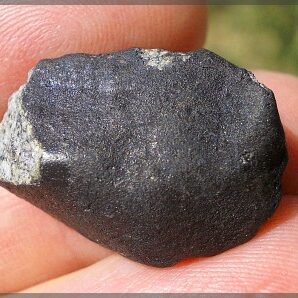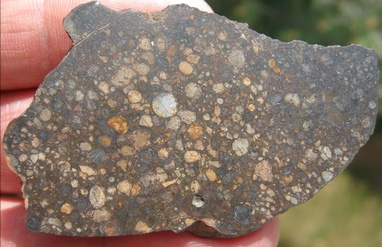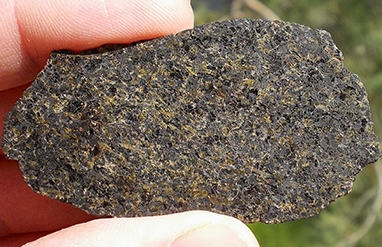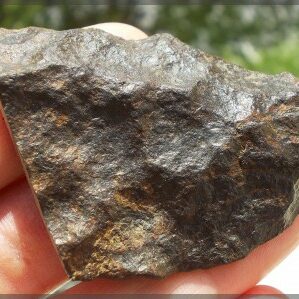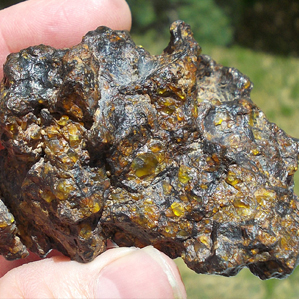Stony
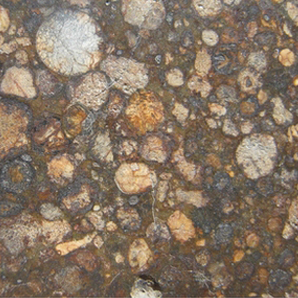
Iron

Mixed
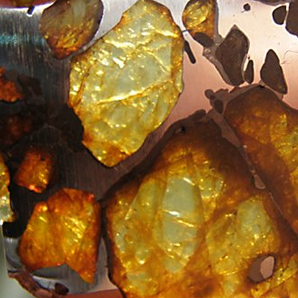
THE CHONDRITES
Ordinary chondrites (groups H, L and LL)
Ordinary chondrites represent alone 80% of the meteorites discovered on earth.
They are composed of very small balls called chondrules that have accumulated one to another.
Chondrite H (high iron)
Chondrite L (low iron)
Chondrite LL (Amphotérites) (low iron, low metal)
Ordinary chondrites have a temperature metamorphism which is graduated from 3 to 7. Higher the number is, more important is the meteorite metamorphism.
For a level 3 metamorphism, the meteorite have an aqueous metamorphism too.
| Type | Characteristics |
|---|---|
| Type 3 | Very well defined Chondrules (rare) |
| Type 4 | Well-defined Chondrules |
| Type 5 | Chondrules still visible recrystallized matrix |
| Type 6 | Chondrules not easily visible recrystallized matrix |
| Type 7 | Crystalline texture (rare) |
Carbonaceous chondrites (group C)
The names of the carbonaceous meteorites were determined, based on several falls used as reference.
Some carbonaceous meteorites have the particularity of having been transformed by an aqueous metamorphism. Carbonaceous meteorites whose metamorphic classification is noted from 1 to 3 have this type of metamorphism. Degree 1 is the degree the most metamorphized by water, that’s why CI (type 1) have not chondrules, disappeared under the action of water.
CM and CR are petrological type 1 or 2, CV, COs and CH are type 3
(degree 3 corresponds to meteorites that have aqueous metamorphism and very low temperature).
CK have a petrological type from 3 to 6.
Chondrite CI
Chondrite CM
Reference fall : Mighei meteorite (Ukraine) fallen June 18, 1889 (8kg)
Chondrite CV
Reference fall : Vigarano meteorite (Italy) fallen January 22, 1910 (16kg)
Chondrite CK
Reference fall : Karoonda meteorite (Australia) fallen in 1930 (41,730kg)
Chondrite CR
Reference fall : Meteorite of Renazzo (Italy) fallen in 1824 (1000g)
Chondrite CO
Reference fall : Meteorite of Ornans (France) fallen July 11, 1868 (6kg)
Chondrite CH
Reference fall : Meteorite ALH 85085 found in 1985 (11.9g)
Chondrite CBa
Reference fall : Bencubbin meteorite (Australia) found in 1930 (118kg)
Enstatite chondrites (group E)
They are divided into two groups, the EL group and the EH group according to their iron content.
Rumurutites (group R)
Represented by the Rumuruti meteorite that fell in Kenya in 1934.
Kakangari Group (K)
Represented by the Kakangari meteorite that fell in India in 1890.
THE ACHONDRITES
They represent only 8% of all meteorites and have no chondrules
The HED Group
This group includes the Howardites (How), the Eucrites (Eu) and the Diogenites (Dio).
The HED are the largest group of the achondrites (6%).
It is assumed that these meteorites come from an asteroid called Vesta.
Ureilites (URE)
They can contain diamond and are very difficult to saw.
The Aubrites (AUB)
They are clear and contain minerals unknown on Earth.
The Angrites (ANG)
The S.N.C.
These meteorites come from Mars, they are represented by three
meteorites (Shergotty, Nahkla, Chassigny), which gave their name to this group.
Lunar meteorites (LUN)
They are more expensive than meteorites from Mars, because we are sure of their origin.
They can be compared with samples brought back from the Moon by NASA.
Primitive achondrites
In this group, there are the Brachinites (BRA, represented by the Brachina meteorite found in 1974), the Lodranites (LOD, represented by the Lodran meteorite fall of 1868), the Acapulcoites (AL represented by the Acapulco meteorite fall of 1976) and the Winonaite
(WIN represented by the Winona meteorite found in 1928).
The Stony- Iron meteorites
In the category of mixed or metallo-stones, there are Pallasites and Mesosiderites composed of a mixture of silicate and metal.
Pallasites
They are very aesthetic in thin and polished slice because they often contain crystallized grains of olivine. It was the German Pallas who first discovered this type of meteorite in 1775 in Siberia.
Mesosiderites
They probably come, like the HED, from the asteroid Vesta.


